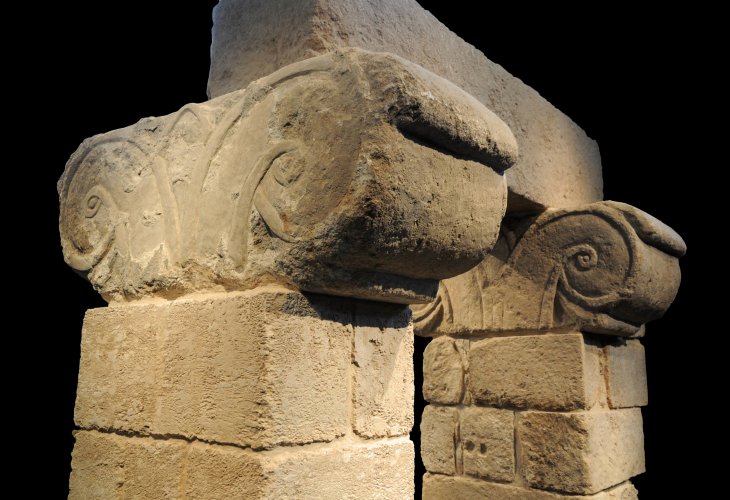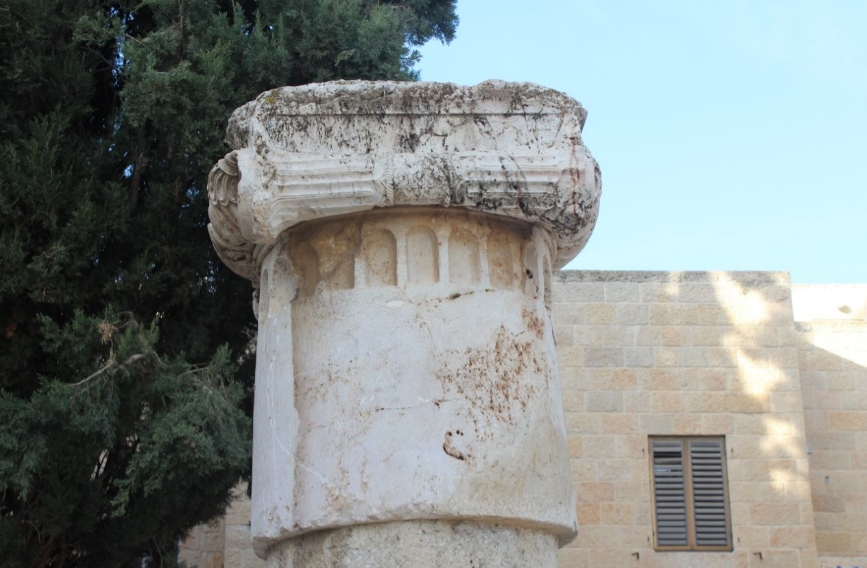Discovering Solomon's Legacy: How Torah Inspired Ancient Architecture
Unveiling the Secrets of the Proto-Aeolic Capitals: A Revelation from Rabbi Zamir Cohen's New Book "Biblical Archaeology Vol. III"
 Column capitals resembling a Torah scroll, from the palace of the kings of Israel at Hazor
Column capitals resembling a Torah scroll, from the palace of the kings of Israel at Hazor"We can envision the walls of Solomon's Temple and Palace... The proto-Aeolic capital (found near the Temple Mount) is likely the only architectural remnant from Solomon's Jerusalem discovered so far," wrote a thrilled Kathleen Mary Kenyon, one of the most influential archaeologists of the twentieth century, who led excavations in ancient Jerusalem.
Torah at the Top
This column capital known as the "proto-Aeolic capital" was familiar to archaeologists from Greek and Roman architecture, with a general consensus that this beautiful and impressive design was the work of stone-crafting designers from those regions.
However, during excavations near the Temple Mount in Jerusalem from 1961-1967 by Kathleen Mary Kenyon, head of the British School of Archaeology in Jerusalem, archaeologists were surprised to find such a capital from a period earlier than Greek and Roman times. The capital was found broken into two parts within a collapse that likely originated from the nearby hilltop, perhaps from the Temple Mount itself or the adjacent Ophel area, thought to hold Solomon's Palace, and it is now displayed at the Israel Museum. This design is known from public buildings and governmental palaces from various countries, including Israel, from later periods – seen in places like Megiddo, Hazor, Ramat Rachel, Samaria, and more. However, the discovery of this capital from the early monarchy in Israel revealed that this design had existed in Israel hundreds of years before it reached Greece and Rome.
 The Scroll Unrolled, a design from a period later than Solomon
The Scroll Unrolled, a design from a period later than SolomonAs is known from the Bible, Hiram, King of Tyre, sent craftsmen from his country to assist David and Solomon in their building projects in Jerusalem. In light of the ancient capital's discovery from the First Temple period, some have concluded that the Israelites – and later the Greeks and Romans – learned this design from the Phoenician craftsmen who came from Tyre.
Yet, examining this capital reveals a fascinating detail that could shed light on the original designer's identity of this magnificent capital, admired by researchers as a masterful stone carving, serving as a model for imitation by Greek and Roman artisans.
If we attentively observe the appearance of the capital from its front and back sides, it becomes clear that the curving at the stone's edges on both sides is not a random decoration but rather intended to shape the form of two scroll cylinders.
More precisely, the capital is shaped like a single unrolled scroll, with two cylinder scrolls on either side, similar to the open Torah scroll look! (As known to anyone who has been called to read from the Torah, it is not read like a single scroll with one side fully open and the other side rolled, but instead has two parchment scrolls on either side of the open sheet for reading).
Since the capital was discovered near the Temple Mount, it's now widely agreed that its design timing is at the latest during the time of King Solomon. Considering the biblical description that aside from the House of the Forest of Lebanon and the Hall of Judgment, Solomon built a Hall of Columns in his palace. It is reasonable to assume with high probability that capitals of this type were used for the columns in Solomon's Temple.
Accordingly, it stands to reason that King Solomon, reputed as the wisest man, was the one who designed the Torah-scroll-like capitals at the top of all the monumental columns in his royal buildings, so that anyone observing the capitals at the top of each column would see an impressive image of numerous open Torah scrolls rising above them! This was to honor and glorify the Torah, which is at the heart of every Jew's attention.
As years passed, architects from other nations adopted and slightly modified the innovative and impressive Israelite capital design into Greek and Roman architecture, preserving the scroll shape, hence their term for it "volute" ("scroll"). Since it was customary for them to wrap the parchment scroll cylinders to prevent them from opening and getting damaged, these architects added an ornamental clasp to the scroll cylinders' center.
Thus, the capital's name should not be "proto-Aeolic" but "Torah Scroll Capital."
The King of Israel and the Torah
In addition to the personal connection that every Jew has with the Torah, which serves as the Creator's instructions on how to act in every situation in life, the King of Israel was commanded in the Torah to subject himself even more to the Torah, initiating measures to continuously remind him that he must differ from various tyrannical rulers who, upon ascending to their thrones, became cruel to their subjects believing they were above judgment. He had to remember that he was a mortal king, subject like any other person to the Creator's instructions in His Torah.
Indeed, the Torah was so dominant in the king's life that he was commanded in the Torah:
"And it shall be when he sits on the throne of his kingdom that he shall write for himself a copy of this Torah in a book, from before the priests, the Levites. It shall be with him, and he shall read from it all the days of his life, so that he may learn to fear Hashem his God, to keep all the words of this Torah and these statutes to do them, so that his heart not be lifted above his brothers, and that he may not turn aside from the commandment to the right or to the left, so that he may prolong his days in his kingdom, he and his children, in the midst of Israel."
As the details of the king's Torah commandment are explained in the Oral Torah: "He writes a Torah scroll for his name. Goes to battle – brings it with him. Enters – it goes with him. Sits in judgment – it is with him. Reclines – it is opposite him, as it is said: 'And it shall be with him, and he shall read from it all the days of his life.'"
It is evident now that King Solomon, the greatest of kings, whose actions like his immense wisdom were monumental, and as he added ten golden menorahs to the main golden menorah made by Moses in the Temple, wished to further emphasize his reliance on the Torah by adorning the tops of all his palace columns with the appearance of Torah scrolls.
Purchase the book "Biblical Archaeology Vol. III" at Hidabroot Shops,click here.
To purchase the "Biblical Archaeology" trilogy set at Hidabroot Shops, click here.

